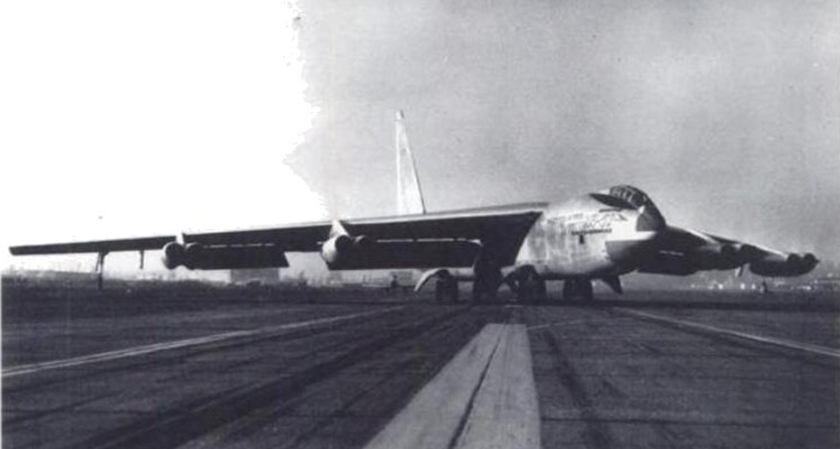New plane wheels land teen at big research competition
Emerson Burkard designed a new wheel system to help aircraft better weather winds

A plane performs a “crab landing,” where its nose is pointed into the wind and its wheels are aligned with the runway. The pilot must now try to straighten out the plane.
Loftin/NASA, Wikimedia Commons
LOS ANGELES – All his life, Emerson Burkard wanted to fly a plane. The 17-year-old got his wish two years ago when he started training for his pilot’s license. As he flew, the teen became impressed with the high winds he frequently faced. Wind can make landing a plane dangerous. A pilot has to fight against wind gusts to get the plane’s wheels to roll straight down the center of the runway. Last month, this rising senior at Manlius Pebble Hill School in Dewitt, N.Y., revealed a possible solution.
He designed a new kind of landing gear. Its special swiveling plane wheels automatically adjust when the plane is landing. The development won him a spot here, at the 2014 International Science and Engineering Fair. The yearly competition is sponsored by Intel and run by the Society for Science & the Public. It brings together high school students from around the world to show off science projects and inventions. (SSP also publishes Science News for Students and this blog).
During his pilot training, Emerson learned to perform “sideslip” and “crab” landings in windy weather. When a plane is landing, the wheels of the plane have to point straight down the runway. But when the wind is blowing across the runway, it can put force on the side of the plane. This can tilt it during landing, causing it to crash on one wing. To protect the plane, a pilot often has to fly into the wind, which means approaching the runway at an angle. Then, at the last minute, the pilot must suddenly straighten out the plane so that its nose now aligns with the center of the runway.
Emerson wondered if there wasn’t some way to land a plane sideways. This way the pilot would not have to worry about straightening out the aircraft at just the precisely right moment.
The teen’s new solution focuses on a plane’s wheels.
Right now, a plane’s wheels, like car wheels, turn relatively slowly. Changing direction involves turning a steering wheel or manipulating a joystick. But if the wheels could align with the runway independently of the nose direction, he reasoned, the nose of the plane could remain pointed into the wind, whatever direction that might be, while the wheels rolled straight down the center of a runway.
The teen decided to test out a rotating wheel. He looked at swiveling caster wheels, like those on the front of shopping carts. Swiveling caster wheels can rotate swiftly in any direction, no matter which way a vehicle is facing. This means that the wheels should be able to straighten automatically when they hit the ground and point into the direction of plane’s overall trajectory.
Emerson tinkered with two model planes. He attached caster wheels to one. The other kept its normal wheels. Then he ran both of them down a wire toward a model runway. Each time, the planes attempted to land with their noses 12 degrees to the left or right of the center line of the runway. “I decided to test them in a controlled, underground setting, to make sure I had a consistent landing pattern,” he explains— “I used my basement.”
When angled to the left or right, the plane with regular wheels faltered and fell over. The wheels could not deviate from their alignment with the nose of the plane. So if the nose of the plane was not traveling centered over the runway, neither were the wheels. When the plane came in at an angle, the left and right wheels hit the ground and veered off, tipping the plane.
But the plane with rotating caster wheels landed successfully. Its freely turning wheels could swivel to point forward down the runway as the plane landed, even when the plane’s nose remained off-center.
Emerson is now using a computer program to see if he can integrate autopilot (a system that controls the direction of a vehicle without direct human action) into his design. A camera placed on the front of the plane would allow the computer autopilot to sense depth and the direction of the runway. The system could rotate the caster wheels automatically to align with the runway, even though the nose of the plane might be facing in a different direction.
Eventually, Emerson hopes to see his concept applied to real planes. Adding autopilot might help prevent pilots from making errors as they land with the new wheel attachments. “The most dangerous parts of being on a plane are the first and last three minutes of flight — the parts with takeoff and landing,” he says. “I hope that this system can make it safer.”
Follow Eureka! Lab on Twitter
Power Words
autopilot A system that can control the direction of a vehicle, such as a plane, without the need for an operator to manually guide it, keeping his or her hands on the wheel. The system still requires an operator to be present. In aeronautics, it can assist with anything from helping land a plane to holding a plane at a certain direction, altitude and/or speed.
model A simulation of a real-world event (usually using a computer) that has been developed to predict one or more likely outcomes.
programming (in computing) To use a computer language to write or revise a set of instructions that makes a computer do something. The set of instructions that does this is known as a computer program.







